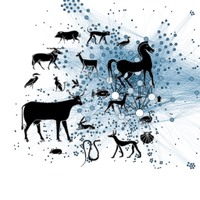Feed efficiency of lactating Holstein cows was not as repeatable across diets as within diet over subsequent lactation stages
This article has been Reviewed by the following groups
Discuss this preprint
Start a discussion What are Sciety discussions?Listed in
- Evaluated articles (Peer Community in Animal Science)
Abstract
Background
Improving feed efficiency has become a common target for dairy farmers to meet the requirement of producing more milk with fewer resources. To improve feed efficiency, a prerequisite is to ensure that the cows identified as most or least efficient will remain as such, independently of diet composition. Therefore, the current research analysed the ability of lactating dairy cows to maintain their feed efficiency while changing the energy density of the diet by changing its concentration in starch and fibre. A total of 60 lactating Holstein cows, including 33 primiparous cows, were first fed a high starch diet-low fibre (diet S + F - ), then switched over to a low starch diet-high fibre (diet S - F + ). To know if diet affect feed efficiency, we compared the ability of feed efficiency to be maintained within a diet over subsequent lactation stages, known as repeatability of feed efficiency, with its ability to be maintained across diets, known as reproducibility of feed efficiency. To do so we used two indicators: the estimation of the error of repeatability/reproducibility, which is commonly used in metrology, and the coefficient of correlation of concordance (CCC), which is used in biology. The effect of diet change could also lead to a change in cows sorting behaviour which could potentially affect feed efficiency if for example the most efficient cows select more concentrate than the least efficient. We therefore analysed the relationship between the differences in individual feed refusals composition and the differences in feed efficiency. To do so, the composition of each feed refusal was described with its near infra-red (NIR) spectroscopy and was performed on each individual feed ingredient, diet and refusals and used as composition variable. The variability of the NIR spectra of the refusals was described with its principal components thanks to a principal component analysis (PCA). The Pearson correlation was estimated to check the relationship between feed efficiency and refusals composition, i.e. sorting behaviour.
Results
The error of reproducibility of feed efficiency across diets was 2.95 MJ/d. This error was significantly larger than the errors of repeatability estimated within diet, which were 2.01 MJ/d within diet S - F + and 2.40 MJ/d within diet S + F - . The CCC was 0.64 between feed efficiency estimated within diet S + F - and feed efficiency estimated within diet S - F + . This CCC was smaller than the one observed for feed efficiency estimated within diet between two subsequent lactation stages (CCC = 0.72 within diet S + F - and 0.85 within diet S - F + ). Feed efficiency was poorly correlated to the first two principal components, which explained 90% of the total variability of the NIR spectra of the individual refusals. This suggests that feed sorting behaviour did not explain differences in feed efficiency.
Conclusions
Feed efficiency was significantly less reproducible across diets than repeatable within the same diet over subsequent lactation stages, but cow’s ranking for feed efficiency was not significantly affected by diet change. This loss in repeatability across diets could be due to a more pronounced feed sorting subsequent to the change in diet composition. However, the differences in sorting behaviour between cows were not associated to feed efficiency differences in this trial neither with the S + F - diet nor with the S - F + diet. Those results have to be confirmed on diets having different forage to concentrate ratios to ensure that the least and most efficient cows will not change.


